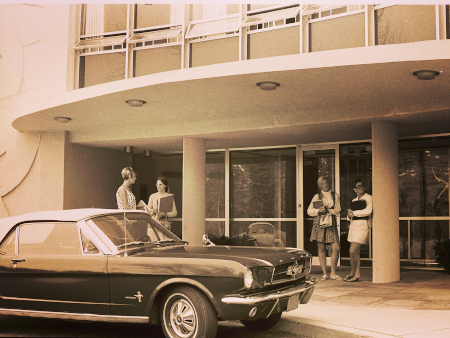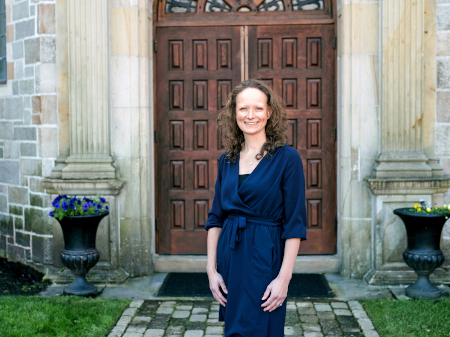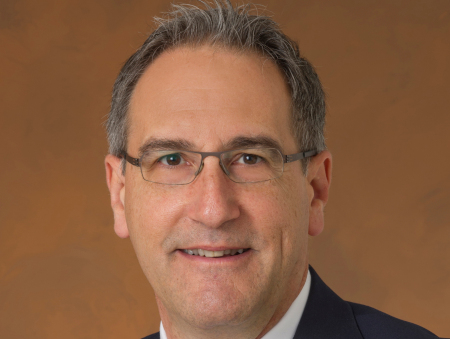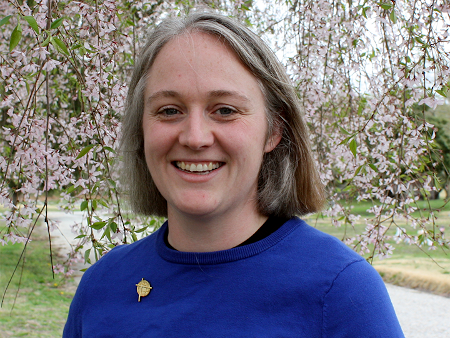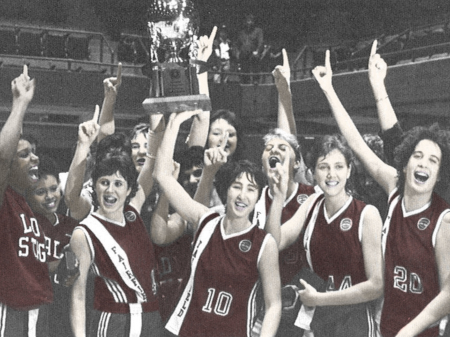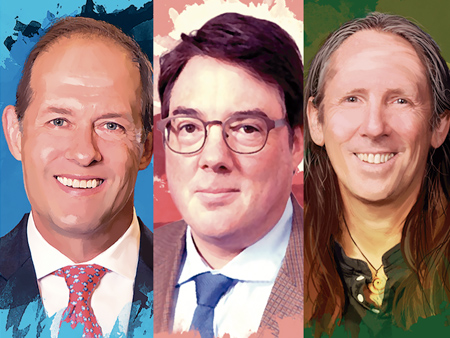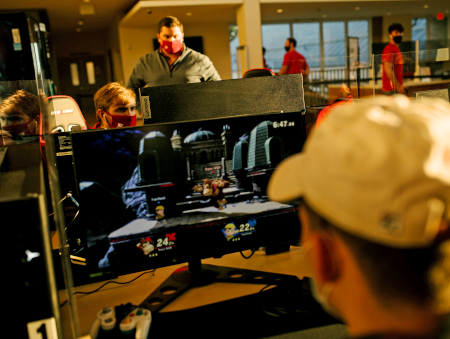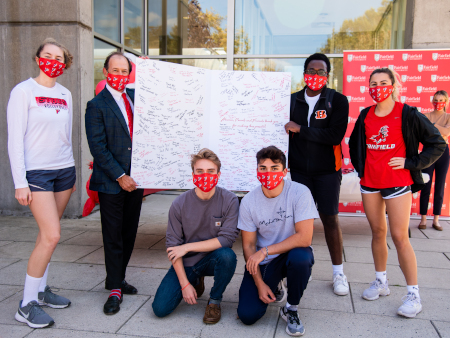50 Years Of Women At Fairfield University
Despite the Jesuits’ progressive vision of education and their willingness to charter a new Catholic liberal arts college in Connecticut in the midst of a global war, original plans for Fairfield University in 1942 did not include women.
Still, women found their way in. In 1949, female nursing students at Bridgeport and New Haven hospital programs took liberal arts classes on Saturday mornings in Xavier Hall. The same year, Fairfield began offering six-week summer school sessions to both men and women in a wide range of subjects from “Fundamental Accounting” to “God and Creation.” And when the Graduate Department of Education opened in 1950, women enrolled alongside men in teacher certification and master’s programs.
Recognizing women’s valuable contributions to education, the Fairfield Jesuits awarded a doctor of laws in 1953 to nationally known educator Margaret V. Kiely, PhD, dean of the faculty at Queens College in New York; she was the first woman to be given an honorary degree from Fairfield. A decade later, in 1963 the University hired its first full-time female professors in the College of Arts and Sciences: both graduates of all-female Radcliffe College, Austrian-born Dorothy Shaffer, PhD, taught mathematics and Joan Walters, PhD, went on to become the first woman to chair the Economics Department, teaching four decades of Stags until her retirement in 1996.
In the mid-1960s, as the Second Vatican Council was preparing to pronounce that women had the right “to acquire an education... equal to [that] recognized for men,” women’s roles in American society were shifting, and an increasing number of colleges in the Northeast were becoming coeducational – leaving male-only institutions to face stiffer competition for applicants.
Shortly after his arrival in 1964, Fairfield University’s fifth president, Rev. William C. McInnes, S.J., began conversations about coeducation with the Board of Trustees, the faculty, and the undergraduate student body.
A February 1967 poll published by The Stag, Fairfield’s campus newspaper at the time, showed students 56 percent in favor of coeducation. Offered an opportunity to voice their opinions, pro and con, responses in the “pro” camp ranged from practical (“If we are to be men of the future we must be able to deal with women of the future.”), to open-minded (“You can’t consider yourself fully educated until you’ve experienced an appreciation for another’s view...”), to resigned (“Why not? The other schools seem to survive. It will come sooner or later, so why not now?”)
Opposing viewpoints ran the gamut from staunch (“Why should we do what other colleges do? Let us keep Fairfield the good school it is now.”) to conciliatory (“I think the best thing that could be done would be to establish a separate all-girls’ college somewhere near...”). Two months later, a follow-up poll in The Stag indicated that the student sentiment had shifted away from coeducation and in favor of a co-institutional arrangement with an all-women’s college.
Fairfield’s Board of Trustees spent the next year exploring the feasibility of a “coordinate” women’s college, akin to a Radcliffe or Barnard, but in the end, with unanimous faculty approval, they resolved to initiate coeducation on the undergraduate level. In February 1969, a Stag article titled “Equal Acceptance Basis for Women in 1970” announced that the school would admit undergraduate women into the College of Arts and Sciences – both as transfer students and members of the Class of 1974, beginning in the fall of 1970. Plans were also announced to open a School of Nursing.
And so, on the heels of St. Peter’s in 1966 and Georgetown (as well as Connecticut neighbors Yale and Trinity) in 1969, Fairfield University officially became coeducational in 1970, the same year as Boston College. The College of the Holy Cross would follow in 1972, and Fordham in 1974.
The 1970s: Setting the Tone for Inclusivity
A total of 234 women and 1,879 men arrived on Fairfield’s campus for the fall 1970 semester, surpassing an undergraduate enrollment of 2,000 for the first time in the school’s history. Twenty women were enrolled in the new School of Nursing, headed by Elizabeth K. Dolan, PhD — the first woman dean in Fairfield’s history.
About 80 women commuted, and the rest moved into residence halls. Split among Julie Hall and the first two floors of Loyola Hall, the women’s living quarters included carpeted hallways, full-length mirrors, and ironing boards. According to an October 1970 article in the student newspaper, the University also provided “additional dresser space for the girls two weeks after their arrival, when they discovered that the allotted space was insufficient.”
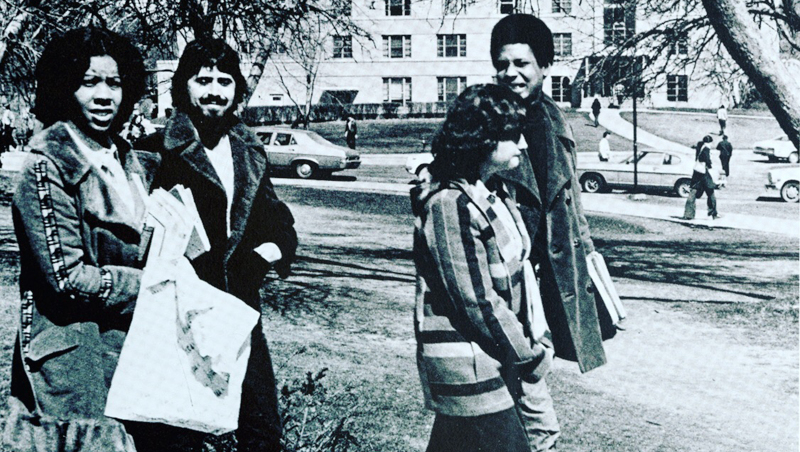
Coeds from the Class of 1975 photographed walking across Fairfield’s campus for the Manor yearbook.
Women’s intramural sports teams were established in flag football, tennis, and basketball. A cheerleading team also took off. The student newspaper reported that “the football, hockey, and rugby clubs admit girls on a non-playing basis, with Glee Club being the only major organization not permitting coed membership.”
Whether allowed to sing with the men or not, the first women undergraduates at Fairfield set the tone for inclusivity, moving the culture of the University forward and opening doors for today’s women to become leaders in student programming, academics, and athletics. Early trailblazers include Susan (Coon) Howard ’74, the first woman editor-in-chief of The Manor yearbook; Karen (Stonkas) Ponton ’74, the first female valedictorian; Amy Zigmont ’76, the first female editor of The University Voice student newspaper; Geralyn (Radowiecki) Spollett ’76, the first woman president of the student legislature; Claire (Carney) Schimpf ’76, the first female Loyola Medalist; and biology professor Phyllis C. Braun ’75, PhD, who, in 1979 became the first alumna to join the Fairfield faculty and still teaches today.
Upon graduating, Ponton, a nursing major, became the first woman appointed to the Fairfield University Board of Trustees. She served from 1974 until 1981, and also taught at the School of Nursing during the ’80s. By then, the nursing program had grown in both size and reputation. From the start, the combination of rigorous coursework, cutting-edge clinical training, and Ignatian pedagogy churned out highly sought after graduates for a profession described in an early program brochure as “rich in association with people and in the rewards of providing needed service.”
Initially dubbed the Stagettes, the first two women’s varsity sports programs were tennis in the fall and basketball in the winter of 1974. Both teams became known as the Lady Stags a few years later; today, all Fairfield athletics teams go by the name Stags. The tennis team was coached by Tamma O’Mara, assistant recreation director, making her the first woman to coach a varsity sport. O’Mara was also the first director of the Recreation Complex (RecPlex) when it opened in 1979.
The women’s basketball team was coached by a classmate, Gary Dittrich ’74. Elevated to DIII varsity play in ’74-75, Coach Dittrich took the women to their first and only undefeated season ever (16-0) — a distinction for which the team was honored in 1995, the same year Coach Dittrich was inducted into the Athletic Hall of Fame.
Founding team leader, Diane Oakley ’75, later served on the University’s Board of Trustees from 1997 until 2004. In recognition of her long- time support of Stags sports programs, Oakley was presented an inaugural Fairfield Athletics’ Distinguished Service Award and named a “Leader of the Herd” in 2014.
Capturing the Connecticut State Championship title in 1978, the women’s basketball program moved to Division II in 1979, the year that Coach Dianne Nolan MA’89 – the first full-time women’s varsity coach – was hired.
Coach Nolan brought the basketball team up to Division I play in 1981, and saw the women to their first MAAC Championship in 1988 (see page 36 for the full story). After two more MAAC championships in 1991 and 1998. and with a school-record 456 wins, Coach Nolan stepped down at the end of the 2007-08 sea- son, telling the Mirror, “This team has been like my baby that I have raised for 28 years, and you never want to leave unless you feel like your baby is OK; I really feel like this team is in a good place and that was important to me.”
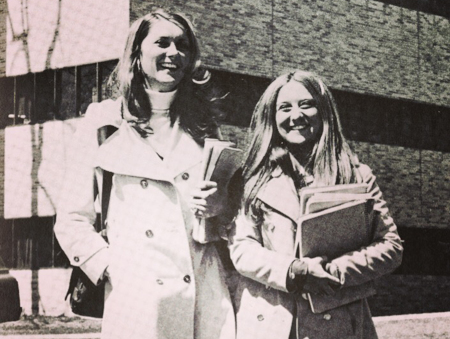
The School of Nursing opened with a cohort of 20 undergraduate students.
The 1980s: Support for Women by Women
As Fairfield approached the 10th anniversary of coeducation, female undergraduate students outnumbered males for the first time, by 52 to 48 percent.
The University marked the 10th anniversary of women on campus in 1980 with a panel discussion, “Women: Changing Roles and the Quality of Life,” featuring prominent women’s voices of the day at Fairfield: Board of Trustee member Judge Ellen Bree Burns; Dean Phyllis Porter, PhD, of the School of Nursing; and Dorothea Braginsky, PhD, still a popular psychology professor and entertaining lecturer today.
The 10th anniversary celebration also featured entertainment by the Women’s Chorale, which had been formed in the early ’70s to complement the steadfastly all-male Glee Club. Carole Ann Maxwell, DSM, P’02 joined Fairfield as director of choral activities in 1980, and two years later she and Orin Grossman, PhD, established the Chamber Singers, Fairfield’s first mixed choir.
In 1987, all three choral groups officially integrated to form the first coed Fairfield University Glee Club. Led by Dr. Maxwell to this day, and accompanied by pianist Beth Palmer, the Glee Club has performed internationally throughout Europe, and in prestigious venues across the U.S.
Heralding a second decade of leadership “firsts” at Fairfield, in her junior year Donna Margine ’81 was the first women’s basketball player to surpass 1,000 career points. Margine is one of only two Fairfield women’s basketball players to average better than 20 points per game in a season and she remains the most accurate shooter in school history, with a .556 field goal percentage. She served as assistant Stags coach from 1981 until 1985, and in 1987 became the first alumna to be inducted into the Fairfield University Athletic Hall of Fame.
Laurie Keane ’83 became the first woman station manager for University radio station WVOF in 1981, and the following year, classmate Jill Krusinski ’83 was named the first female editor-in-chief of The Fairfield Mirror, which succeeded The University Voice in 1977 and remains the student newspaper to this day.
Suzanne Lyngaas, MBA, CPA, assistant professor of accounting, was the first woman at Fairfield to be honored with Alpha Sigma Nu’s “Teacher of the Year Award” in 1987 and she was also the first professor ever from the School of Business to do so.
Georgia Fayetta Day, PhD, was appointed associate dean of the Graduate School of Education and Allied Professions in 1988. With a doctorate from Syracuse and a master’s from Gallaudet University, Dr. Day taught the first-ever course in American sign language at Fairfield, and she was active in Project BEST (Black Educational Specialists Training), a federally funded grant program that trained Black teachers in special education.
The 1990s: A Model of Equality
Entering the third decade of coeducation at Fairfield, controversy regarding the role of women in the Church swirled in December 1990. “Bishop Bans Women From Altar,” read the Mirror’s front-page headline when, contrary to established Campus Ministry policy, it was announced that only men would be permitted on the altar for the dedication ceremony of the new Egan Chapel of St. Ignatius Loyola.
The Jesuits, separate from the Diocese of Bridgeport, had for years welcomed women lectors and Eucharistic ministers on the altar for campus Masses and liturgical celebrations, but women at the time were not permitted on the altar at diocesan events that involved the Bishop. Campus Ministry Assistant Chaplain Paula Oddis boycotted the dedication ceremony in protest, telling the Mirror, “The issue is about what we are used to here [at Fairfield] and that’s a model of equality.”
Weeks later, Oddis resigned and was replaced by Sr. Anne Flood, SC. In a 1992 Mirror interview, Sr. Anne praised the “climate of equality at Campus Ministry,” but noted that “the influence of women in the Church is a burning issue, and an important issue that should be explored more.”
Protests shifted from the chapel to the Campus Center in 1992, when a group of faculty members and students approached the University Council — a governing body made up of faculty, administrators, and students —and called for the campus snack bar/pub, then called The Stag-Her Inn, to be renamed. Council chair Robert Maina ’93 told the Mirror, “I feel that if the snack bar [name] is seen as an act of harassment, it must be addressed.”
The Stag-Her Inn’s name had been an attempt at inclusivity back when it first opened in 1973, but two decades later, it seemed no longer compatible with the changing times. The Stag-Her Inn sign was removed from the establishment on the grounds that it “may be taken as a sexist slur or an image of alcoholic indulgence.”
The Council ran a full-page ad in the paper, asking for new name suggestions. Submissions included “Fitz’s Place,” “Campus Center Lounge,” and “The Stag Club.” Ultimately, the controversy was resolved in 1995 when a new pub was built on campus and christened The Levee. An eatery remains to this day in the Barone Campus Center, called simply The Stag Snack Bar.
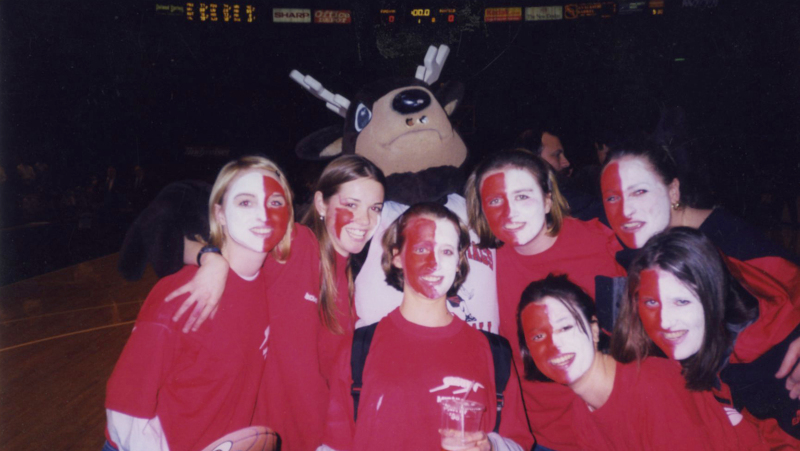
Basketball fever ran high in the late 90s as the Stags made NCAA appearances in '97 (men) and '98 (women).
Mary Frances Malone, PhD, became the first woman to hold one of the University administration’s 12 key leadership positions in 1993, when she was promoted to associate academic vice president – a role she held for an unprecedented 25 years. Dr. Malone founded the University’s Ignatian Residential College program and oversaw its growth into today’s three sophomore living and learning communities.
Reflecting back on her career, Dr. Malone said, “I owe a great deal to the collective that is Fairfield University. My years here have opened my eyes, my mind, and my heart to such a depth of intellectual engagement across disciplines and have deepened my faith in ways too numerable to count.”
Also in 1993, Lauren Nowicki ’93 became the first woman to receive the William J. Kramer ’60 Humanitarian Award, which recognizes a student’s commitment to volunteerism and service to others. That year, the Academic Council approved the first women’s studies minor as part of the Women’s Studies program, co-founded by associate professor of English Johanna Garvey, PhD, and assistant professor of business law Lucy Katz, JD. Katz told the Mirror, “It’s a way to expand the curriculum and bring the University into the 20th century.”
The Women’s Studies program launched an annual “Person of the Year” recognition in 1994, for outstanding contributions to women’s issues. The first award recipient was nursing professor Doris Lippman, PhD, who served in Vietnam as a member of the Army Nurses’ Corp. Thanks to her efforts as vice chair of the Vietnam Women’s Project, a Washington, D.C., memorial was dedicated in 1993 to honor the roughly 11,000 servicewomen of the Vietnam War – close to 90 percent of them nurses.
The award was later renamed the Lucy Katz “Person of the Year” Award. During her 25 years at Fairfield, Katz chaired the Management Department and held the inaugural Robert C. Wright endowed chair in Business Law, Ethics and Dispute Resolution.
Three years before she was hired as director of Alumni Relations, assistant vice president Janet Canepa ’82 became the first woman appointed president of the Fairfield University Alumni Association Board of Directors in 1992. She served a two-year term, representing Alumni Association members in the University community and advancing the involvement, volunteerism, and support of Stag alumni around the world. This pioneering role prepared her well to assume the directorship of Alumni Relations in 1995, just as Fairfield was kicking off celebrations to mark a quarter-century of women on campus.
Canepa oversaw a year of events commemorating the achievements of female faculty, students, and alumnae, including a panel series titled “The Women We Have Become,” featuring reminiscences of Fairfield’s first dean of women, Anne Marie Samway, alongside alumnae trailblazers from the early years of coeducation.
“I think the first women who were admitted to Fairfield wanted to prove they were up to the challenge of competing in what had been and all-male bastion,” Rev. Aloysius P. Kelley, S.J., then-president of the University, told a reporter in a New York Times article about the 25th anniversary of coeducation. “They set very high standards for themselves which have continued to this day. Even after they leave our campus, the contributions our alumni make in their communities and careers bring great honor to Fairfield.”
The 2000s: Glass Ceiling No More
A new team in 1997, women’s rowing won its first MAAC title in 2000. In 2001, field hockey, coached by Jackie Kane ’87, made its first NCAA appearance.
Among the 12 alumni who lost their lives on September 11, 2001 was one woman, Johanna Sigmund ’98, who worked on the 93rd floor of the World Trade Center. On the ten-year anniversary of 9/11, Coach Kane remembered Sigmund, a field hockey student-athlete who wore #24, as the fellow Philly girl who’d gone out of her way to welcome Kane as the team’s new coach in 1995. Sigmund was “an extremely hard worker,” Coach Kane told the Connecticut Post, “and just an all-around terrific person.”
Brenda Joyce (Blissett) Young ’74, PhD was initially slated for Fairfield’s Annual Diversity Convocation in fall 2001, but due to the events of 9/11, it wasn’t until 2002 that she became the first alumna to deliver the convocation address. An English professor, Dr. Young earned her PhD in African American Studies from Emory University. “College is the best and happiest time of life,” she told the students. “Use these years to polish the diamonds that you already are.”
Through the decades, as women on campus attained leadership positions in administrative posts, faculty appointments, and student organizations, the one elusive role for female undergraduates was that of Fairfield University Student Association (FUSA) president. When Karen Donoghue ’03 was elected in 2002 the Mirror head- line proclaimed “Glass Ceiling No More.” Her victory paved the way for the five women who have served in this role since. Donoghue’s career path in higher education brought her back to Fairfield in 2014, where she currently serves as vice president for Student Life. (Learn more in her interview on page 32.)
2010 to Today: Trailblazers Igniting the Future
The Women’s Studies program was rebranded in 2012 to become the Women, Gender, and Sexuality Studies (WGS) program. As a student in the program at the time, Alicia Bissonette ’12 said, “The reason why Women’s Studies was invented was to balance out the male-dominated teaching style of the past. However, as times change, so does the study. I think it’s wise that they are including all genders and sexualities in the conversation.”
Offering an expanded variety of courses that seek to challenge cultural, intellectual, social, and political assumptions about sex, gender, and sexuality systems, the renamed program also hosts a WGS Center on campus, with meeting space and informational resources.
“First Woman and Non-Jesuit to Lead Fairfield University” announced the Connecticut Post headline when then-provost and senior vice president for academic affairs Lynn M. Babington, PhD, was appointed interim president for six months beginning in January 2017. “Fairfield is ready,” Dr. Babington told the newspaper. The former professor and dean of the School of Nursing was asked how her nursing background had prepared her for the role of president. “When you are a nurse, you translate medical information between patient and families and physicians half the time,” Dr. Babington replied, “And when you are a college president, you have to look at the big picture and translate it to families, students, staff, faculty, and the Board of Trustees who are the ultimate overseers.”
Dr. Babington went on to become president of Chaminade University in Honolulu and was replaced at Fairfield by President Mark R. Nemec, PhD, in June 2017. Dr. Nemec appointed Christine Seigel, PhD, provost in 2018. Today, Dr. Siegel is one of eight women in senior leadership positions at Fairfield.
A champion of women faculty members and students, Dr. Siegel has launched a lecture series in celebration of the 50th anniversary of coeducation. The first session, “Women at Fairfield – Trailblazers Igniting the Future,” featured female voices from a cross-section of roles and eras: University Trustee Rosellen Walsh Schnurr ’74, Vice President of Student Life Karen Donoghue ’03, and past Student Achievement Awardee, Claretta Mills ’16. Additional commemorative events are being planned – for full celebration details please visit fairfield.edu/celebrate-women.
Women today outnumber men on campus in both student population and on the faculty. Even beyond campus, there are now more women than men among Fairfield’s 40,000- plus living graduates — something the male students and alumni of 1970 could never have imagined. Embracing the core Jesuit values of the magis and cura personalis, men and women together set the tone for inclusivity and acceptance when coeducation changed the history of Fairfield 50 years ago.
But it was the trailblazing women who set the high bar for achievement — excelling in the classroom, leading organizations and teams, and going on to successful careers — and it is this legacy that continues to open doors for generations of female undergraduates and alumnae.
